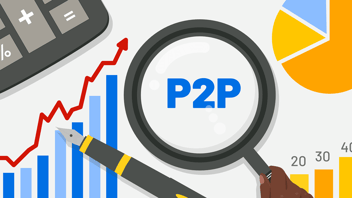P2P implementation insights from actual procurement and lab users
Much has been said about the benefits of procure-to-pay (P2P) software solutions, but there is confusion about what P2P is versus what it is not.
What P2P is…. A platform that integrates purchasing and accounts payable systems, resulting in an end-to-end process from product selection through payment. P2P automates and digitalizes portions of the procurement process, such as purchase order workflow, spend oversight, and integration with ERP systems. All of this increases efficiency and improves the bottom line.
What P2P is NOT… Implementation of a P2P system is not a silver bullet or a clean slam dunk when it comes to automation. While it promises to fully automate the lab supply procurement process, the complexities of the R&D space only allow for automation up to a certain point before grinding to a halt. This disconnect is due to the lab’s need for supplier choice in order to achieve scientific innovation.
P2P platforms, like many software products, sell a perfect customer experience and paint the future state as one marked by complete, effortless automation. But the reality for R&D, life sciences, and biopharma organizations is very different.
ZAGENO, a leading digital lab supply marketplace, had the opportunity to survey procurement managers, lab scientists, and end users at a major pharmaceutical firm that had recently implemented one of the leading P2P systems.
Main Takeaway: It is not possible to achieve 100% automation / consolidation with a P2P system alone due to the robustness of R&D tail spend.
P2P implementation insight #1: Holistic lab supply catalog management with P2P alone is an illusion.
“We thought [one of the major P2P platforms] would completely change the user experience so they could search and find everything in one place. I would say they sold an illusion to our users. Everything would need to be in a hosted catalog for this which we absolutely cannot do.” – Procurement manager
The pharmaceutical company described above has over 2,200 PunchOut catalogs from which their scientists can order. The P2P vendor promised to consolidate this process and make it more user-friendly for both procurement and the lab. After a lengthy implementation process, the procurement team was dismayed to discover that it was their responsibility to upload and maintain all 2,200 catalogs. When prices change, new products are offered, and new deals are negotiated, catalogs become outdated and must be re-uploaded by procurement, a very time-intensive process rife with the possibility of errors and delays.
P2P implementation insight #2: PunchOut catalog navigation is not significantly improved.
“[The P2P system] is not very user friendly and too ‘clunky’ for an occasional scientist user. There are seemingly hundreds of order tabs to negotiate and it takes time to find the correct ones to order from.” — End user / scientist
Users assumed that it would be simple to navigate to and order from any of the 2,200 punchout catalogs linked to the new P2P system. However, many platforms utilize a tile system on the home screen. For example, the purchasing organization selects a finite number of supplier catalogs to be accessible from the P2P home screen. Those slots are usually occupied by the major players, such as VWR and Thermo Fisher. If a scientist can’t find what they need after looking through each of the highlighted catalogs separately, they must sort through the other 2,190 suppliers, often having to navigate between hundreds of separate tabs to locate the necessary item.
P2P implementation insight #3: It is still necessary to jump through hoops to purchase from preferred suppliers.
“Some suppliers are missing from the system that we don't use often but need to and the process of having them added takes weeks and weeks.” — Lab coordinator / procurement coordinator
Once the scientist locates the item, they must complete a special, ad hoc request form in order to make the purchase, which then must be approved by procurement, resulting in delays and inefficiency.
These limitations do nothing to manage long tail spend and almost serve to increase maverick spend. Free text orders abound since there is no real time advantage to using one of the non-primary suppliers. A rampant long-tail results in missed opportunity to leverage volume, with the overall workflow still the same as before.
P2P implementation insight #4: The end user ordering experience remains essentially unchanged.
“Items are very hard to find and where to find. Is it on Fisher or on VWR or should I be looking for a quote and ordering directly? It is very confusing and very time consuming at the beginning to figure out.” — End user / scientist
P2P reduces purchase order cycle time by linking back-end systems, but this does not translate into time advantages for the scientist searching for the right product, at the right price, that is actually available. Scientists reported to ZAGENO that they spend 3.6 hours per week searching supplier sites to find the right product, even after P2P implementation. Rather than being able to search for a specific product across all vendors, the scientist must go to each individual supplier website / catalog to locate the items.
On the flip side, many supply partners don’t realize how onerous it is for scientists to purchase from them. They also don’t understand why their “preferred” status is not resulting in additional sales or an enhanced partnership.
P2P implementation insight #5: Communication overhead issues remain unsolved.
“[After you order] you have to check each item [to see] if it is dispatched since if there is a delay you don`t get a notification. You think, ‘oh, that should have arrived by now, let me check what happened’ and it is not even dispatched yet because there is a delay for 4 weeks suddenly. Then you need to cancel that one because you can`t wait that long, start looking for alternatives and back to the beginning of the cycle. With how often that happens, ordering is quite often a nightmare.” — End user / scientist
Without a centralized, consolidated hub from which to order, order tracking remains a very manual process, usually happening via email and phone calls. Even post P2P implementation, scientists spend 2.4 hours per week communicating with operations teams and/or suppliers to track order statuses. Worse yet, 86% reported experiencing delays in experiments due to backorders.
P2P implementation insight #6: Enhancing a P2P system with a self-service marketplace can help R&D procurement achieve almost complete automation of trunk and tail spend.
In the case of the pharmaceutical company referenced in this article, 1,775 of the 2,270 suppliers (78%) are covered by the ZAGENO marketplace, with the capability to easily add more.
What does that mean? By subscribing to ZAGENO and adding it as an option on the P2P home screen, scientists can easily build a cart from millions of SKUS from thousands of vendors via one marketplace. ZAGENO serves as the sole vendor of record, meaning that there is only one consolidated invoice each month.
By adding ZAGENO to the roster of primary suppliers, lab supply spend can be almost fully consolidated, eliminating the need for free-text or maverick spend.
In 2021, biopharma R&D teams added up to 50% new suppliers to support experiments and address product availability issues, resulting in significant delays and additional work. Adding and onboarding each new supplier can take weeks, even if only one item needs to be purchased.
With a digital lab supply marketplace, on the other hand, new suppliers are all under the umbrella of the marketplace itself as the vendor of record. The same process that might have taken weeks is reduced to days. Scientists can place orders from multiple vendors in the same order, and the invoice comes through as if it was one established supplier. Order tracking is also automated.
Procurement data becomes easily organized through vendor consolidation, allowing for increased spend visibility and enhanced bargaining power. Most importantly, the user experience for scientists becomes as Amazon-like as possible.
No matter the size of the organization or the phase of P2P implementation, it behooves procurement and the lab to investigate the benefits of supplementing their digital procurement strategy with a subscription to a lab supply marketplace, such as ZAGENO. By achieving full automation, R&D can truly focus on what matters—scientific innovation.




